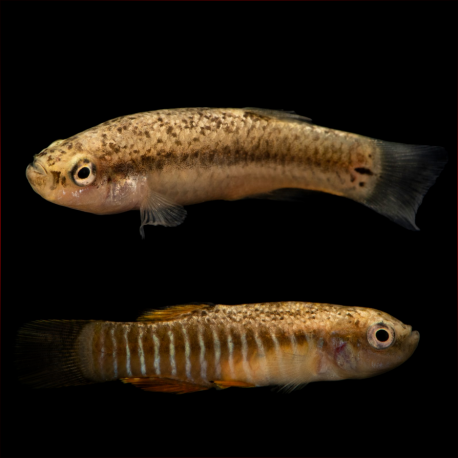More info
Datasheet
| Minimum Tank Size | 60 litres / 15.85 US gallons |
| Maximum Size | 6.0cm / 2.36inches |
| Temperature | 2°C / 35.60°F - 30°C / 86.00°F |
| Hardness | 10.03dgH / 179ppm - 30.03dgH / 536ppm |
| pH | 6.5-8.5 |
General Description
Aphanius villwocki is a species of cyprinodontoid-toothcarps belonging to the Cyprinodontidae family. Endemic to the Sakarya River basin in western central Turkey, it exhibits variations in coloration and patterning depending on locality. The species has a maximum size of 6.0 cm and requires a minimum tank size of 60 litres. A. villwocki is highly adaptable, occupying diverse habitat types ranging from freshwater drainage canals with aquatic vegetation to hypersaline lakes and marshes.
Aquarium Setup
When setting up an aquarium for Aphanius villwocki, it is crucial to maintain a wide temperature range of 2-30°C and avoid excessively acidic conditions. The species does not require artificial heating in most climates but should experience a 'winter' period at low temperatures for optimal health. For tank setup, providing numerous broken lines of sight and suitable surfaces for egg deposition is essential. The presence of acrylic wool mops, java moss, Ceratophyllum, and filamentous algae is recommended to facilitate breeding. No substrate is necessary, although inert sand or gravel can be added, and filtration should not be overly strong. Additionally, offering some natural sunlight exposure daily can enhance the fish's coloration and overall well-being.
Behaviour
Due to its specific water requirements and vigorous spawning behavior, A. villwocki is not well-suited for community aquariums. The species, rare in the hobby, is best kept alone or in a group ratio with two to three females per male. Captive reproduction is emphasized, and maintaining the fish in a dedicated setup is recommended. Males establish temporary territories and display intense coloration to attract females for spawning. A. villwocki is a fractional spawner, with females depositing eggs continuously between April and September.
Feeding and Diet
In their natural habitat, Aphanius species primarily feed on small aquatic crustaceans, worms, insect larvae, and zooplankton, occasionally consuming algae and plant material. In the aquarium, they can be trained to accept dried foods but should also be regularly offered live or frozen foods such as Artemia, Daphnia, or bloodworms, especially during the spring and summer months. Supplementing their diet with a high-quality dried product containing Spirulina is beneficial, particularly in the absence of filamentous algae.
Reproduction & Dimorphism
Captive reproduction of A. villwocki is relatively straightforward with proper tank setup. Females spawn eggs singly or in small batches, attaching them to surfaces using filaments. It is crucial to monitor the eggs daily, as adult fish may consume them. Sexual dimorphism in the species is pronounced, with males displaying yellowish bodies adorned with whitish vertical bars and females being larger and plainer in appearance, featuring fewer markings and hyaline finnage.
Habitat and Distribution
The species is endemic to the Sakarya River basin in western central Turkey, specifically found below the confluence with the Porsuk River. A. villwocki thrives in environments ranging from freshwater drainage canals with aquatic vegetation to hypersaline lakes and marshes. Variations in coloration and patterns are observed based on different localities, emphasizing the importance of labeling distinct forms to preserve bloodlines and maintain accuracy in both hobbyist and scientific settings.

